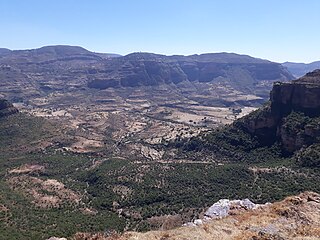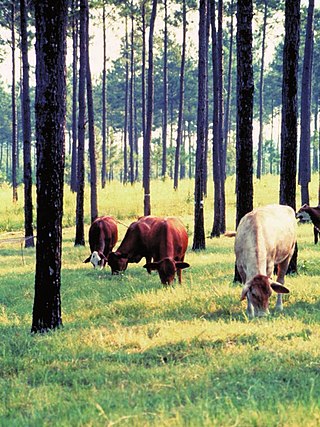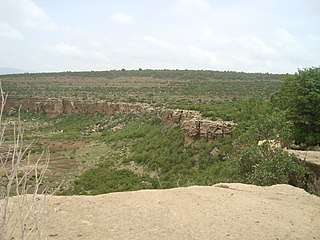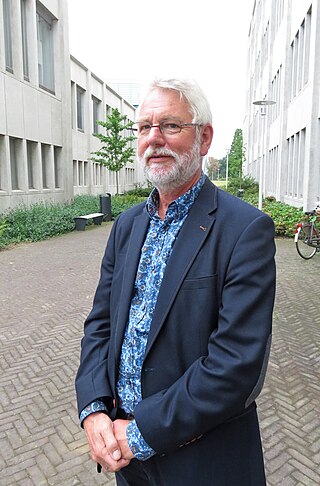
Reforestation is the natural or intentional restocking of existing forests and woodlands (forestation) that have been depleted, usually through deforestation but also after clearcutting. Two important purposes of reforestation programs are for harvesting of wood or for climate change mitigation purposes.

A grassland is an area where the vegetation is dominated by grasses (Poaceae). However, sedge (Cyperaceae) and rush (Juncaceae) can also be found along with variable proportions of legumes, like clover, and other herbs. Grasslands occur naturally on all continents except Antarctica and are found in most ecoregions of the Earth. Furthermore, grasslands are one of the largest biomes on earth and dominate the landscape worldwide. There are different types of grasslands: natural grasslands, semi-natural grasslands, and agricultural grasslands. They cover 31–69% of the Earth's land area.

A savanna or savannah is a mixed woodland-grassland ecosystem characterised by the trees being sufficiently widely spaced so that the canopy does not close. The open canopy allows sufficient light to reach the ground to support an unbroken herbaceous layer consisting primarily of grasses. According to Britannica, there exists four savanna forms; savanna woodland where trees and shrubs form a light canopy, tree savanna with scattered trees and shrubs, shrub savanna with distributed shrubs, and grass savanna where trees and shrubs are mostly nonexistent.

An exclosure, in an area being used extensively for grazing, is a limited area from which unwanted browsing animals, such as domestic cattle or wildlife such as deer, are excluded by fencing or other means.

Bale Mountains National Park (BMNP) is a national park in Ethiopia. The park encompasses an area of approximately 2,150 km2 (830 sq mi) in the Bale Mountains and Sanetti Plateau of the Ethiopian Highlands.

The Goda Mountains lie northwest of the Gulf of Tadjoura, Tadjoura Region in Djibouti. They rise to 1,750 metres (5,740 ft) above sea level and are the nation's largest heavily vegetated area and is the second highest point in Djibouti. The name Goda in Afar means "twisted" or "devoured" and refers to a ridge. A part of the mountains is protected within the Day Forest National Park, Djibouti's only national park. The ecology of this landform is considered an isolated outlier of the Ethiopian montane forest ecological zone, an important island of forest in a sea of semi-desert.

In biology, the canopy is the aboveground portion of a plant cropping or crop, formed by the collection of individual plant crowns. In forest ecology, canopy refers to the upper layer or habitat zone, formed by mature tree crowns and including other biological organisms. The communities that inhabit the canopy layer are thought to be involved in maintaining forest diversity, resilience, and functioning. Shade trees normally have a dense canopy that blocks light from lower growing plants.

Silvopasture is the practice of integrating trees, forage, and the grazing of domesticated animals in a mutually beneficial way. It utilizes the principles of managed grazing, and it is one of several distinct forms of agroforestry.

Margaret D. Lowman, Ph.D. a.k.a. Canopy Meg is an American biologist, educator, ecologist, writer, explorer, and public speaker. Her expertise involves canopy ecology, canopy plant-insect relationships, and constructing canopy walkways.

Dogu'a Tembien is a woreda in Tigray Region, Ethiopia. It is named in part after the former province of Tembien. Nowadays, the mountainous district is part of the Southeastern Tigray Zone. The administrative centre of this woreda is Hagere Selam.

The Waterberg is a mountainous massif of approximately 654,033 hectare in north Limpopo Province, South Africa. The average height of the mountain range is 600 m with a few peaks rising up to 2000 m above sea level. Vaalwater town is located just north of the mountain range. The extensive rock formation was shaped by hundreds of millions of years of riverine erosion to yield diverse bluff and butte landform. The ecosystem can be characterised as a dry deciduous forest or Bushveld. Within the Waterberg there are archaeological finds dating to the Stone Age, and nearby are early evolutionary finds related to the origin of humans.

The walia ibex is a vulnerable species of ibex. It is sometimes considered an endemic subspecies of the Alpine ibex. If the population were to increase, the surrounding mountain habitat would be sufficient to sustain only 2,000 ibex. The adult walia ibex's only known wild predator is the hyena. However, young ibex are often hunted by a variety of fox and cat species. The ibex are members of the goat family, and the walia ibex is the southernmost of today's ibexes. In the late 1990s, the walia ibex went from endangered to critically endangered due to the declining population. The walia ibex is also known as the Abyssinian ibex. Given the small distribution range of the Walia ibex in its restricted mountain ecosystem, the presence of a large number of domestic goats may pose a serious threat that can directly affect the survival of the population.

Pando is a clonal organism representing an individual male quaking aspen that spans 106 acres and is both the largest tree by weight and the largest tree by landmass, and is also the largest known aspen clone. Pando was identified as a single living organism because each of its estimated 47,000 stems (ramets) possesses identical genetic markers. Each of the stems also is generally connected by a massive interconnected root system that coordinates energy production, defense and regeneration across its expanse. Located in the Fremont River Ranger District of the Fishlake National Forest along the transition zone between of the Colorado Plateau and Basin and Range in south-central Utah, United States, Pando lives 0.43 miles west of Fish Lake, the largest natural mountain freshwater lake in Utah.
Monodominance is an ecological condition in which more than 60% of the tree canopy comprises a single species of tree. Monodominant forests are quite common under conditions of extra-tropical climate types. Although monodominance is studied across different regions, most research focuses on the many prominent species in tropical forests. Connel and Lowman, originally called it single-dominance. Conventional explanations of biodiversity in tropical forests in the decades prior to Connel and Lowman's work either ignored monodominance entirely or predicted that it would not exist.

Forest restoration is defined as “actions to re-instate ecological processes, which accelerate recovery of forest structure, ecological functioning and biodiversity levels towards those typical of climax forest” i.e. the end-stage of natural forest succession. Climax forests are relatively stable ecosystems that have developed the maximum biomass, structural complexity and species diversity that are possible within the limits imposed by climate and soil and without continued disturbance from humans. Climax forest is therefore the target ecosystem, which defines the ultimate aim of forest restoration. Since climate is a major factor that determines climax forest composition, global climate change may result in changing restoration aims. Additionally, the potential impacts of climate change on restoration goals must be taken into account, as changes in temperature and precipitation patterns may alter the composition and distribution of climax forests.

Debre Nazret is a tabia or municipality in the Inderta district of the Tigray Region of Ethiopia. It belonged to Dogu'a Tembien up to January 2020. The tabia centre is in Togogwa town, located approximately 19 km to the east-southeast of Hagere Selam and 25 km to the west of Mekelle.

Dr Frans Vera is a Dutch biologist and conservationist. He has played a key part in devising the current ecological strategy for the Netherlands. He has hypothesised that Western European primeval forests at the end of the Pleistocene epoch did not consist only of "closed-canopy" high-forest conditions, but also included pastures combined with forests, a hypothesis variously addressed as the Vera hypothesis or the wood-pasture hypothesis.
Aster Afwork GebrekirstosFAASTWAS is an Ethiopian scientist and a professor of agroforestry at World Agroforestry Centre (ICRAF).
Masresha FeteneFAAS is an Ethiopian professor of Plant Ecophysiology at the Department of Plant Biology and Biodiversity Management, Addis Ababa University.
















